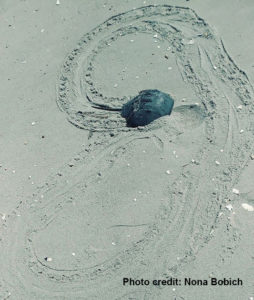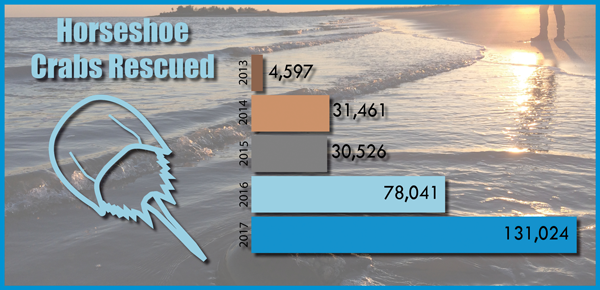 Every spring, Delaware Bay host the largest concentration of spawning horseshoe crabs on the Atlantic Coast. Surveys estimate 300,000-1,300,000 horseshoe crabs annually come ashore onto NJ Bayshore beaches and are in greatest numbers during spring tides in May and June. Their population has been significantly reduced from overharvesting and habitat loss in the 1990s, and every year thousands die after being overturned by waves or becoming stuck in both natural and man-made hazards. Long-distance migratory shorebirds that rely on horseshoe crab eggs to refuel on their remarkable journeys declined along with the horseshoe crabs.
Every spring, Delaware Bay host the largest concentration of spawning horseshoe crabs on the Atlantic Coast. Surveys estimate 300,000-1,300,000 horseshoe crabs annually come ashore onto NJ Bayshore beaches and are in greatest numbers during spring tides in May and June. Their population has been significantly reduced from overharvesting and habitat loss in the 1990s, and every year thousands die after being overturned by waves or becoming stuck in both natural and man-made hazards. Long-distance migratory shorebirds that rely on horseshoe crab eggs to refuel on their remarkable journeys declined along with the horseshoe crabs.
The Wetlands Institute has been working on a host of projects to help the recovery of horseshoe crab populations ranging from working to help restore Sandy ravaged beaches, to actively rearing horseshoe crab hatchlings, and leading the charge to develop and implement a horseshoe crab rescue program.
The reTURN the Favor program was launched five years ago as a collaborative program, sanctioned by the NJ Division of Fish & Wildlife and managed by The Wetlands Institute and the Western Hemisphere Shorebird Reserve Network (WHSRN). Since its inception, the reTURN the Favor program has been an amazing success. It takes a village – and in this case – the community support has been unbelievable. Twenty two beaches are part of the rescue effort with nine organizations coordinating volunteer training and rescue walks. The overall goals of reTURN the Favor are to rescue stranded and trapped horseshoe crabs, increase awareness of horseshoe crabs, shorebirds, and their management, and collect data and information on stranded crabs, potential hazards, and tagged crabs to aid in management and restoration.
The program has expanded and strengthened each year – from the number of people engaged, to the number of horseshoe crabs rescued, to improved data collection. Volunteers have stepped up to lead reTURN the Favor walks and people of all ages have joined to help, contributing more than 7,000 volunteer hours. In 2017 the total number of crabs rescued over five years surpassed 275,000. For each crab rescue, we collect data to understand specific areas that were especially dangerous for crabs. With financial support from funders including the NJ Coastal Wetlands Restoration Partnership, NJ Conserve Wildlife Matching Grant Program, and South Jersey Industries, we have been able to address threats on beaches to improve conditions and decrease impingement risk to spawning crabs. Efforts focused on removing 32,000 lbs of rubble from Moore’s Beach, to repairing dilapidated bulkheads, and cleaning debris from spawning beaches.
The reTURN the Favor program continues to demonstrate that the simple act of rescuing stranded crabs can become an impactful one, as large numbers of crabs can be helped with a unified effort of engaged and knowledgeable volunteers. So far, it appears to be succeeding—through five seasons and incredible effort from volunteers and partners, the program has already rescued more than a quarter million horseshoe crabs that otherwise may have been lost. The results are clear: when more people are engaged, and more walks are conducted, more crabs are rescued. There is still more to do. Going into its sixth year, funding is needed to ensure this program can continue to thrive. Since program inception, The Wetlands Institute and WHSRN have provided the staff and resources to implement and manage the program. If you’d like to help us keep the program viable and growing, please let us know. If you’d like to join a walk, or become a trained volunteer, go to returnthefavornj.org to sign up and learn more.

